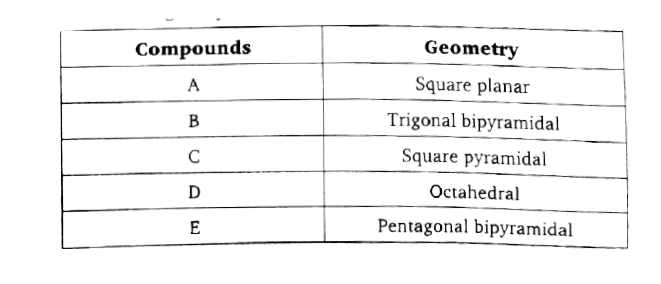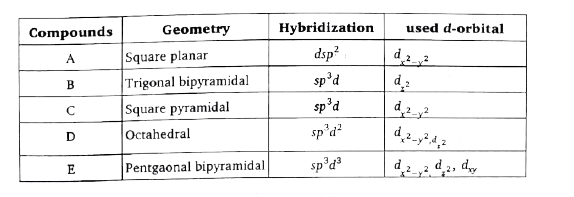Consider the following compounds with their regular geometries.

Calculate value of (x+y−z)2, where x is total number of axial d-orbitals having zero nodal plane, y and z are total no. of non-axial and axial d-orbitals respectively each one having two nodal planes used in hybridisation of central atoms of compounds A to E.
The correct Answer is:0

x=dx2=3
y=dxy=1,(x+y−z)2=(3+1−4)2=0
z=dx2−y2+4
Topper's Solved these Questions
- CO-ORDINATION COMPOUNDSBOOK - VK JAISWALCHAPTER - CO-ORDINATION COMPOUNDSEXERCISE - LEVEL 1
202 Videos
- CO-ORDINATION COMPOUNDSBOOK - VK JAISWALCHAPTER - CO-ORDINATION COMPOUNDSEXERCISE - LEVEL 3 (PASSAGE TYPE)
97 Videos
- CO-ORDINATION COMPOUNDSBOOK - VK JAISWALCHAPTER - CO-ORDINATION COMPOUNDSEXERCISE - MATCH THE COLUMN
36 Videos
- CHEMICAL BONDING (BASIC)BOOK - VK JAISWALCHAPTER - CHEMICAL BONDING (BASIC)EXERCISE - Level 3 (Passive 11)
6 Videos
- d-BLOCK ELEMENTSBOOK - VK JAISWALCHAPTER - d-BLOCK ELEMENTSEXERCISE - SUBJECTIVE PROBLEMS
6 Videos
Similar Questions
Knowledge Check
In which of the following species, d-obitals having xz an yz two nodal planes involved in hybridization of central atoms?
AIO2F−2BClF−4CIF7DNone of theseIn which of the following species, d-obitals having xz an yz two nodal planes involved in hybridization of central atoms?
AIO2F−2BClF−4CIF7DNone of theseIn which of the following species d-orbitals having xz and yz two nodel planes involved in hyridisation of central atom?
AIO2Fө2BSF6CIF7DNone
Which of the following species used both axial set of d-orbitals in hybridisation of central atom ?
View SolutionConsider the following orbitals (i)3px (ii)4dx2 (iii)3dx2−y2 (iv)3dyz
Then, calculate value of "x+y−z" here x is total number of gerade orbital and y is total number of ungerade orbitals and z is total number of axial orbitals in given above orbitals.
View SolutionConsider the following orbitals (i)3px (ii)4dz2 (iii)3dx2−y2 (iv)3dyz
Then, calculate value of "x+y−z" here x is total number of gerade orbital and y is total number of ungerade orbitals and z is total number of axial orbitals in given above orbitals.
View SolutionWhich of the following species has used both axial set of d-orbitals in hybridisation of central atom ?
View SolutionIf two different non axial d−orbitals having xz nodal plane form π−p∮by overlapping each other, then internuclear axis will be
View Solution
